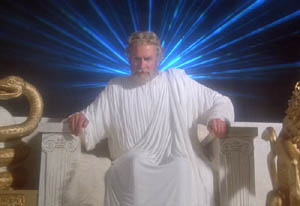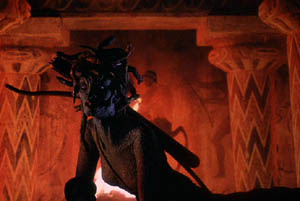|
Special effects legend Ray Harryhausen's crowning achievement, Clash of the Titans is one of those beloved childhood films I've seen dozens of times, and which never seems to get old, though it does seem to age. An entirely pleasurable film to watch, it's the kind of cinema that almost no one would attempt to produce today (and the 2010 remake pretty much proves this). 
The story follows the classic Greek myth of Perseus, son of Zeus, with some parts of the script accurate to the original legend, some parts confabulated from multiple stories, and some parts freely made up. Having grown up on a peaceful desert island, Perseus awakens one evening to discover he has been magically transported to Phonecia, a kingdom suffering under some malignant curse. The spirit of their princess, Andromeda, is enslaved to a satyr-like creature named Calibos, who gives her riddles to present to any would-be suitors. Anyone unable to solve the riddle is burned at the stake, a consequence of Calibos's possessive jealousy, as he once was betrothed to Andromeda, and now skulks in the bordering swamplands, nursing his bitterness. Looking upon her, Perseus determines to court her in spite of the curse, and in so doing makes an enemy not only of Calibos, but of his mother, the goddess Thetis, who unknown to Perseus was the one responsible for taking him from his sheltered existence and dropping him in the cursed city of Joppa. Ultimately he will have to face all manner of mythological monsters and other obstacles in order to save Andromeda from being sacrificed to a huge sea beast, the Kraken. 
Titans is an odd little film, a film which never felt modern at any point during its actual existence. It's the slickest, most star-studded early '60s adventure film ever, except that it was made in 1981. The style of the whole package, from the set design to the stagey acting style to the special effects all belong to an earlier era of film. The stop-motion creature effects, while unquestionably a high water mark for the artform, were dated before they ever hit the screen, although no less impressive for it, stop-motion being incredibly difficult and tedious to execute well. This is not an action film, but rather an adventure film, an entirely different animal which, although certainly containing action, doesn't feel the need to utilize the rush-rush-rush approach of modern examples of the genre, preferring instead to take its time evolving the plot and establishing character relationships. We care about Andromeda's fate because Perseus cares so very much. Neither are the villains given short shrift: while Calibos is the primary threat to our heroes and a dangerous killer, he's also rather sad and pitiable. A new character created for the film (inspired largely by Caliban from Shakespeare's The Tempest), he's a counterpoint to Perseus: the son of a goddess who indulged his every whim until Zeus punished him for his selfishness and cruelty, he now lives only for revenge against Perseus for taking away the last thing he loved. It's a more lyrical, romanticised form of storytelling than we typically see any more. At the same time, this ostensibly kid-friendly, PG-rated adventure flick manages to slip in no fewer than three nude scenes, something which also would be near-unthinkable today. Perhaps the internet is so choked with far less tasteful examples of same nowadays that it's deemed unnecessary, but there's something about it, possibly due to countless occurrances in their own artwork, that feels utterly Greek. I expect legions of twelve year-old boys who probably counted the minutes until Andromeda's bath scene in repeat viewings were grateful for it, in any case. 
No discussion of this film would be complete without a generous nod towards Ray Harryhausen's creature work, which, dated though it might have been, nevertheless reflected his extreme talent and dedication. Indeed, the phenomenon of the "Harryhausen film" is something with no modern equivalent; who today files a film under the name of its chief effects technician rather than its actual director? In this, his last film, he applies his exemplary skill in animation to bring to life mythological creatures such as the Kraken, Pegasus, a group of giant scorpions, and of course Medusa. Who could ever forget the still, quiet sequence in which Perseus and his men are stalked by the Gorgon through a firelit temple? With not only the character's basic movements but also a head filled with writhing snakes to animate, coupled with the necessity of changing the light every frame to replicate the look of flickering torchlight, it stands as probably the most technically accomplished example of this lost art. I'm sure the audience for this sort of movie still exists out there; the success of the similarly-paced Lord of the Rings trilogy would seem to confirm that audiences still enjoy a fantasy film that takes its time with plot and relationships whenever they're lucky enough to find one. I don't know if modern, young audiences, so used to photo-real, near-seamless effects will be able to look past the visible artiface and enjoy this film purely on the basis of its story, or if they'll be able to see it in the context of its time and enjoy the artistry of a pre-digital, hands-on style for what it was. I would, however, suggest that it's worth the attempt. -review by Matt Murray
|
|
||||||||